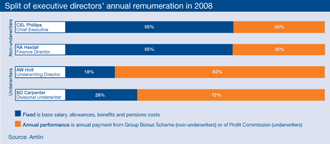Accountability
Directors’ remuneration report
Sir Mark Wrightson
Committee Chairman
Amlin’s remuneration policies are designed to support its vision and strategic objectives, specifically:
- To secure the maximum possible alignment between the interests and long term career development of executive directors and other senior employees with the ambitions of the Company and the creation of value for its shareholders.
- To have first class employment practices, contributing to Amlin being “the place to work” for high quality people in its sector. This requires levels and structures of remuneration that are appropriate to attract, retain, incentivise and reward the high calibre talent that is required for the success of the Company.
- To reward management focus both on immediate financial measures, such as return on equity and underwriting returns, and on longer term objectives such as underwriting cycle management and the long term sustainability of the business.
Overview
The Remuneration Committee of independent non-executive directors is responsible for ensuring that the Group’s vision and strategy is supported by its remuneration policies and practices. It seeks to perform its role consistently with Amlin’s stated core values, which include:
- Integrity (independence, objectivity);
- Professional excellence (proper process and governance, on the basis of full information and professional advice);
and - Leadership (being aware of market trends, but shaping Amlin’s policies to its own specific needs)
Following a strategic remuneration review by the Committee in 2005-06, the consequential adoption of a number of new incentive plans in 2006 and the first awards under them in 2006 and 2007, there were few changes in the Group’s remuneration policies and practices in 2008.
Looking ahead, the crisis in the banking and securities industry led the Financial Services Authority to write to financial services sector Chief Executives in October 2008 signalling its more active interest in the remuneration policies and practices of all financial service providers. The Committee accepts the importance of remuneration structures taking account of risk management and good compliance practice as well as maintaining an appropriate balance between rewards for long term sustained performance and those related to more immediate financial returns. The Committee had already ensured that each of the Group’s incentive schemes have mechanisms that take account of such factors. The schemes with the greatest potential rewards, those for the underwriters, are based on reserving struck on average over three years after business is written, providing incentives for writing business with long term merit rather than with inappropriate risk/ reward ratios which may only be exposed by the passage of time. All schemes also include discretions to withhold payment in the event of non-compliance with standards required by the Company or a participant causing reputational damage to the business. Thus, although the Committee believes that many of the remuneration practices giving rise to the FSA’s and other stakeholders’ concern are less applicable to non-life insurers such as Amlin than to other parts of the financial services industry, it will take a close interest in how the FSA’s views develop and, as part of a planned review in 2009, will carefully consider the extent to which any of the issues raised should lead to changes to either the Company’s remuneration structures or their implementation.
The present structure of the various elements of senior executive remuneration, distinguishing between directors who are underwriters and those who are not, is summarised in the first of the two charts below. As well as a Long Term Incentive Plan measured over a three year performance period (the LTIP), both underwriters and non-underwriters have incentive plans with the potential to earn significant rewards by reference to five year performance periods, thereby incentivising the longer term sustainability of the business (the Capital Builder Plan for underwriters and the Performance Share Plan (PSP) for non-underwriters).

Click here for full sized image
The split of remuneration of each executive director in 2008 is summarised in the chart above. These include amounts paid (or due as at the year end) in the annual performance reward category but not long term incentive plan payments or awards. The split between fixed and annual performance payments shows that a significant proportion of directors’ remuneration was performance related. The annual performance rewards for non-underwriters in 2008 were lower than in recent years as percentages of salary as a result of the lower return on equity for the year. The effect of lower returns in 2008 is not yet evident in underwriters’ rewards as the profit commission payments reported all relate to 2007 and earlier underwriting years and hence their rewards have a greater lag. The splits between the categories of reward, together with the longer term performance rewards described later in this report, reflect the Committee’s objective of aligning management and shareholders’ interests.
Further details of each element of the above components of 2008 remuneration are set out in later sections of this report.
